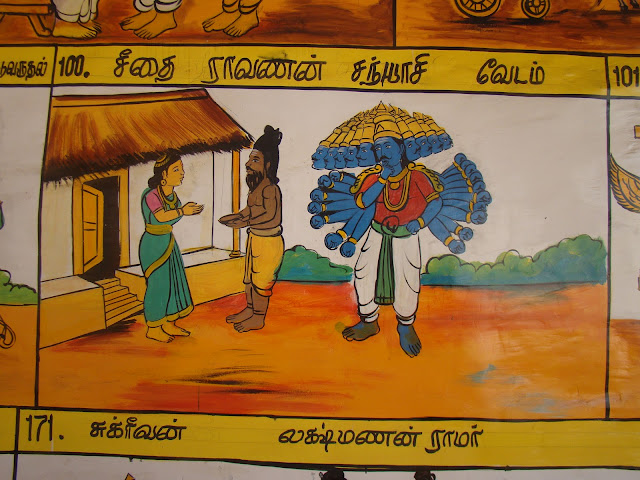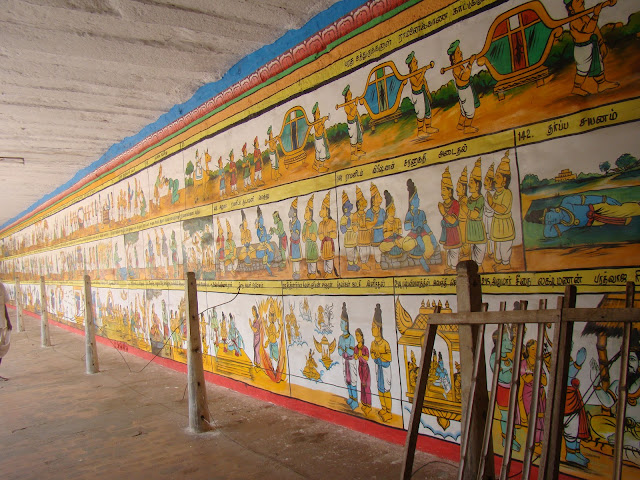Ramaswamy Temple, Kumbakonam
Ramaswamy Temple is a Hindu
temple dedicated to
Lord Rama, an incarnation of Lord Vishnu located in Kumbakonam, Tamil
Nadu, India. The Ramaswamy Temple which depicts the paintings
of Ramayana is another important Vaishanavite temple in
Kumbakonam. The greatness of Ramaswamy Temple is said to be the only temple
where Lord Rama, Goddess Sita are in the same platform and Lord
Hanuman is playing the Veena instead of reading the Ramayana. The entire deity
is said to be made from Saligrama monolith. The Temple is filled with intricate
carvings in its pillars.
Legends
Dasaratha King of Ayodhya was sad as he had no issues to
look after the kingdom after him. As advised by Guru Vasishta, he
conducted a yajna called Puthrakameshti Yajna seeking child boon. To
establish Dharma on Earth Lord Vishnu was born to him as Rama from his first
queen Kausalya. Vishnu’s Adisesha and conch were born as Lakshmana
and Satrugana to his second queen Sumitra. Bharatha representing
Vishnu’s discus was born to the second queen Kaikeyi and was a symbol of Dharma
himself. Rama, Lakshmana, Bharatha and Satrugana were born on very
auspicious days with Punarvasu, Pushya, and Aslesha as their birth stars
respectively. All the four brothers were a living and practical
example in human forms of the rule of Vedas. Rama and Lakshmana were close
to each other while Satrugna was close to Bharatha.
Bharatha, an outstanding example of the political dharma
of the days, ruled Ayodhya as its acting Governor of Rama from the Nandhi Grama
placing Rama’s sandals on the throne. He ruled till the return of
Rama from his exile after 14 years. Their wives excelled their husbands in
upholding Dharmas.
No power on earth could separate the
brothers. They were united by soul and mind. Lord Sri Rama in
the temple appears as on the Coronation Day in Ayodhya with his consort Mother
Sita who suffered untold suffering during their exile, Lakshmana who was only
happy to share the hardships of jungle life along with his brother, Bharatha
and Satrugna whose sacrifice deserves all praise and Sri Anjaneya who was the
soul of Rama in deciding his final victory over Ravana. After
Ayodhya in U.P. this is the temple in Kumbakonam in the coronation style, a
pilgrim town known for its famous temples and Theertha – Sacred waters –
importance.
History
Achutha Nayaka of Thanjavur constructed the Ramaswamy
temple during 16th century. Maha Mandapam is enriched with intricate
stone carving works of Rama-Katha. Vamana Avatharam, Meenakshi Kalyanam,
Sukreeva Pattabishekam are some of the famous carving works of this temple. The
outer Praharam consists of all 219 wall paintings, which explains the series of
incidents from the great Epic "Ramayanam”. Alwar Sannathi, Srinivasa
Sannathi, and Gopalan Sannathi are the other temples located within the temple
complex.
Ramaswamy Temple was built by King Achutha Nayaka who
ruled Tanjore from 1614-1640 CE. He was an ardent devotee of Lord Rama, the
incarnation of Vishnu who killed the ten-headed demon Ravana.
King Achutha Nayaka dug a holy tank in Darasuram near
Kumbakonam. During the digging they found icons of Rama and Sita in the tank. The
King was overjoyed and he decided to build a temple for Rama and called it
Ramaswamy Temple. The Nayak king’s Prime Minister Govinda Dikshitar, called
Govinda Ayyan, constructed the temple. He added a commercial corridor between
this new temple and the older Chakrapani Temple.
Speciality
Five Vishnu temples are connected with Mahamaham festival which happens once in 12 years in
Kumbakonam. They are Sarangapani Temple, Chakrapani Temple, Ramaswamy Temple, Rajagopalaswamy Temple and Varahaperumal Temple. This temple, one among them, is situated in the north
of Big Street.
Lord Sri Rama blesses the devotees with all his brothers
and Mother Sita. While Sri Hanuman appears with his club in all Vaishnava
temples, he is holding a Veena here.
Greatness of Temple
Lord Sri Rama and Mother Sita are seated together in the
sanctum sanctorum in wedding posture. In Other temples they grace
from their separate shrines. Devotees believe that praying in this temple
would bring them a match with a sacrificial quality for the sake of the
other. Satrugna is on the left of Lord with a Samara fanning his
brother, Bharatha holding the Royal Umbrella and Hanuman on the right and
Lakshmana appears with his bow as usual.
Sri Anjaneya graces here with a Veena against his usual
appearance with a club. He is free here from the war mind and
singing the glory of Lord Rama. This also shows that Sri Hanuman is
not only an erudite scholar but a good musician too. He is holding
the Ramayana epic in one hand. It is said that He is singing the
Ramayana story. The temple has all the features that Ramayana tells
us and is a feast to Rama bhaktas.
The temple
The temple has a 3-tiered gopuram surrounded by walls.
The central shrine houses the image of Rama in a seated posture with his
consort Sita. The other images are of his brothers Lakshmana, Bharatha and
Chatruguna in standing posture and Hanuman in worship posture. The pillars in
the hall near the gopuram are sculpted with exquisite finesse depicting various
episodes of the epic Ramayana. Each pillar is carved out of a single stone and the
delicacy is very prominent. Rama in the temple is depicted
with Vyakarna Mudra, while Hanuman is depicted holding manuscripts. The
other important aspects of the epic like coronation of Vibishana, coronation
of Sugriva, relieving Agalya from her curse and Hanuman playing Veena are
depicted. The temple is a typical of Nayak style of temples.
The temple has beautiful architecture pieces and has
been built by the Nayakkar kings. Govinda
Dikshitar, the prime minister of
the Nayaks, constructed the temple. He added a commercial corridor between his
new temple and the older Chakrapani temple.
It is said to be the only temple where Lord Rama,
Goddess Seeta are in the same platform and Lord Hanuman is playing the Veena
instead of reading the Ramayana. It was built in the 16th century by
Achutha Nayaka of Thanjavur and is constructed in Dravidian style of
architecture. The temple has beautiful pieces depicting art and architecture.
The Main deities of Ramaswamy temple are Lord Rama, Lady
Seeta, Lakshmana, and Lord Anjaneyaa. The sculptures of all the deities are
said to be made from original Saligrama monolith rock. The Karuvarai, the
central sanctum, of the temple houses Lord Ramaswamy in a seated with his wife
Lady Seeta. The other deities surrounding them are the brothers of Lord Rama,
Lakshmana, Bharatha and Chatruguna who are standing near them and close by is
Lord Hanuman sitting and worshipping Lord Rama and Seeta.
The temple has a 3 story Gopuram surrounded by walls and
the pillars in the hall near the Gopuram are sculpted with exquisite finesse
depicting various episodes of the epic Ramayana. Each pillar is carved out of a
single stone and the delicacy and intricacy of the carving and the detailing of
the artwork are very prominent. Lord Rama is depicted in Vyakarna Mudra, while
Hanuman is depicted holding manuscripts. The other important events like
coronation of Vibishana, coronation of Sugriva, relieving Agalya from her curse
and Hanuman playing Veena are also depicted. Apart from the Gopuram, the temple
complex also comprises of a Maha Mandapam. The columns of Maha mandapam are
enriched with intricate stone carvings depicting incidents such as Vamana
Avatharam, Meenakshi Kalyanam, Sukreeva Pattabishekam and Ramayanam. Apart from
the main temple, the complex also houses the Alwar Sannathi, Srinivasa Sannathi
and Gopalan Sannathi. There is also a shrine for Lord Perumal with Mothers
Sridevi and Bhoodevi in the temple.
The Utsava-vigraha of the Sri Räma, Sri Sitä,
Lakshmana and Hanuman is placed before the mülavigraha. Images of
the mülavigraha, at least of Sri Räma and Sri Sitä are clearly visible
from the road.
The
Carved Pillars:
The sixty-two pillars in front of
the mandapam are great works of art. They hold individually Räma
standing with Kodanda, Sitä, Hanuman, Räma and Sitä sitting together, many
ornamental ladies, and a lady with sophisticated footwear.
Temple
Paintings:
Very distinct and unique features of the Ramaswamy
Temple are the walls of the Praharam on which the story of the Ramayana is
depicted in the form of a series of paintings. One can go through the entire
Ramayana pictorially whilst taking 3 pradakshinams (rounds) of the inner
sanctum, the Karuvarai. All these wall paintings are made with herbal colours
and the local artists help in maintaining the condition of these paintings.
Scenes from Ramayana are painted on three
walls of the prakaram, numbered and catalogued.
Temple Opening Time
The temple is open from 6.00 a.m. to 12.00 a.m. and from
4.00 p.m. to 9.00 p.m.
Festivals
Sri Rama Navami is celebrated in the temple with special
pujas in March-April – Panguni Tamil month. On the Masi Maga day in
February-March, Lord Sri Rama and Mother Sita visit the Maga Magam Temple Tank
for a bath and offer Theertha Prasad to devotees.
Prayers
Those facing obstacles in their wedding proposals pray
here as Lord and Mother appear in their wedding posture. In Ayodhya,
they appear in coronation style. Devotes perform Thirumanjanam to Lord and
offer vastras.
Contact
Arulmigu Ramaswamy Temple,
Kumbakonam-612001, Thanjavur
Phone: +91 435 2401788
Connectivity
The temple is at the southern end of the Big Bazaar Street
in Kumbakonam linked by road and rail from all corners of the state. The
temple is located right in the centre of Kumbakonam.































